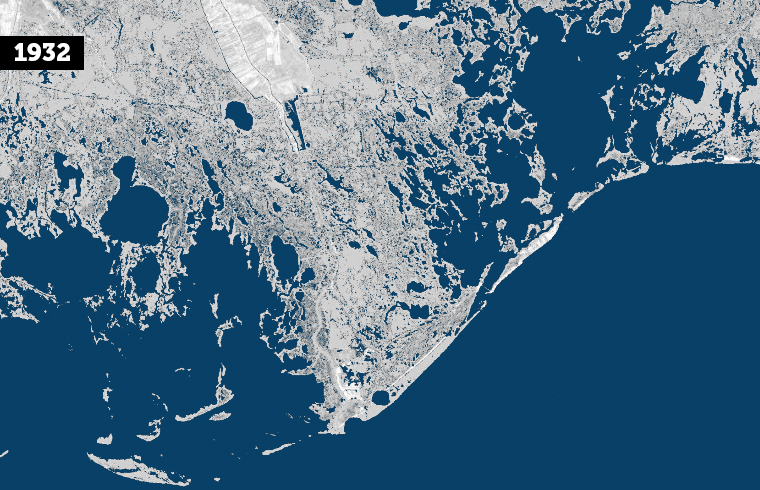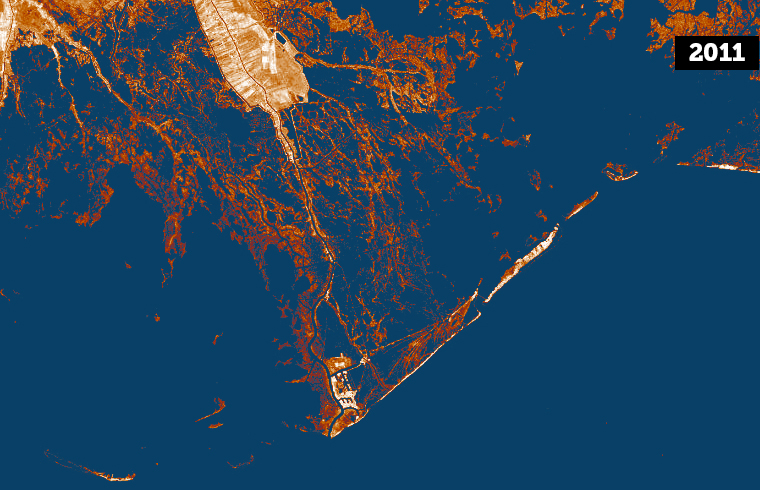Science & Community
On the last day of my first trip to the Gulf I drove out to the small town of Bohemia along the Mississippi River. Located near the end of Louisiana highway 39 Bohemia is a small unincorporated oystering village that was still suffering from disastrous decisions made during the spill when freshwater was introduced into the estuarine system destroying much of the oyster habitat along the Mississippi river.
In Bohemia I met Byron Encalade a constable in Plaquemines Parish, a Vietnam veteran, an oysterman and president of the Louisiana Fisherman’s Association. With a wealth of life experience, much of it spent on the water, I was cautious to bring up the role of science thinking that he’d be suspicious of anyone from outside of his community coming in and offering advice about how he should live his life—especially after his oysters were wiped out by bureaucratic decisions. Soon into our conversation I mentioned a local scientist, Thomas Soniat, who was studying salinity conditions that oysters need to live in. I was surprised at Byron’s reaction when I mentioned the scientist: far from antagonistic, Byron was complimentary of him even going as far as to call Soniat a hero of his. He continued in this vein saying that he wished there was more involvement between his community and scientists: “Fishermen are able to tell you things that could assist you in science…these fishermen are out here seeing what's happening everyday. But our problems is, we need science. We need good science. We need policies based on science.”
Although there were some people who wanted to just be left alone, most of those, from people living along the Yuccatan Peninsula in Mexico to those living along the Mississippi River in Louisiana, told me that they wanted to know more about their environment and that science would help them make better decisions.
Byron Encalade & Thomas Soniat featured in The Folly of Human Decisions.
If people have knowledge they are they are in a better position to determine their fate and that is why Byron and so many others like him were seeking that knowledge. Without the ability to quantify what he sees, without the ability to understand what environmental factors cause the decline in his fish and oyster stocks, without the ability to present evidence behind his observations there’s not much he can do or petition for. All he can do is say things are not like they used to be after the spill. But if he had good science, he’d be able to make make a case for his community and make better decisions for himself.
A Troubling Trend
From the time I finished shooting in December 2016 to the release of Beneath the Horizon now in April 2017 America’s scientific institutions are facing drastic cuts due to the change in political parties following the presidential elections. The Environmental Protection Agency (EPA) is facing 31% in cuts. The National Oceanic Atmospheric Administration (NOAA) budget has been proposed to be cut by 17%. Alarmingly, the cuts to NOAA will specifically target coastal management and coastal resilience programs which help protect the coasts when storms strike. Funding for satellites that track storms and weather patterns (and also oil spills) are proposed to be cut leaving the coastal US all the more vulnerable to hurricanes such as Katrina and Sandy.
And much of the content in this project could not have been shared with viewers if it wasn't for the the wealth of information that the EPA, NOAA and the National Air and Space Administration (NASA) made available to the public. NOAA provided the maps that illustrate how coastal erosion in Louisiana has intensified over the past century, NASA satellite imagery tracked the spread of oil in currents and EPA data revealed the extent of surface oiling—all of which convey how the Gulf has coped and is coping with the long term effects of the Deepwater Horizon oil spill.
Slide to view 8 decades of erosion along the Louisiana coast


Imagery comparing Gulf Coast land mass in 1932 and 2011. Photo: NOAA
The data from these institutions help us understand the challenges we presently face and how to best cope with them in the future. Without this information we are left in the dark, blind to the next storm that comes our way or oil spill that washes ashore. (I want to point out that this information has both proved and disproved theories and claims on all sides of the political spectrum revealing that recovery has been stronger in some places where it was thought to be hopeless and it has raised concerns in other places that were thought to be spared, but are struggling to this day.)
Exploration & Bonds Formed
This past summer I visited Mexico with scientists from all over the world as they explored the long term consequences of the IXTOC spill, searching for clues that might help Louisiana recover from the Deepwater Horizon spill. Having witnessed the physical lengths they went though to attain their samples in the field and the rigor applied to their findings in the laboratory, I came away tremendously inspired by their passion and professionalism.
The lengths they go through for their science is not without risk and some of their expeditions have the potential to turn fatal. Indeed, on a trip I was on to visit the IXTOC exclusion zone there was a very good chance that our boat would not make it when the sea suddenly turned violent raising our boat to 40°—perilously close to the tipping point. Had it capsized in such rough waters so far from shore and with no rescue vessels nearby loss of life was all but certain. (This perilous trip was documented in the IXTOC segment.) But without risk there can be no discovery and the world is a better place for the discoveries they make.
Personally, for me as an observer there were moments of great personal joy experienced with the scientists as well—especially when we ventured into the Yucatan’s surviving mangrove forests. It was the first time I had ever ventured into a mangrove forest and had the chance to see their magnificent root systems up close.
To enter into the first mangrove forest our boat, engine cut, glided on the current to an embankment that led into the dense forest. As I entered the forest I felt like I stepped through a portal in time and entered into the late Paleozoic era when our planet was entirely primal, still sultry with the heat and humidity of creation, when when everything was alive and breathing.
Beneath the intense midday Mexican sun the forest was dark, humid, cavernous—and every single thing within it seemed to be alive. I particularly remember the sound of herds of small crabs running from my footsteps as I climbed over the interconnected mangrove roots and sunk into the mud comprised with decaying organic matter. Above me birds nested and along the shore muscles clung to the strong mangrove roots that literally held the island together.
Climbing though this great mass of trees and roots I was reminded of the ending of Oliver Sacks’ The Island of the Colorblind which in part reads: "This forest...has given me an intimate feeling of the antiquity of the earth and the slow continuous process by which different forms of life evolve and come into being. Standing here in the jungle, I feel part of a larger, calmer identity; I feel a profound sense of being at home, a sort of companionship with the earth…. The sense of deep time brings a deep peace with it, a detachment from the timescale, the urgencies of daily life.”
As in awe as I was of the forest around me I had to remind myself that I was, after all, on a scientific mission to understand the effects of a debilitating oil spill. And although the life I witnessed upon entering the forest was indeed something amazing to witness, life there had drastically changed since the spill. I was told by Benebe the fisherman who piloted us there that the muscles I saw clinging to the branches were only a fraction of what they used to be and, as a reminder of the pollutants in the environment, large tar balls could easily be found in the interior.
Benebe and Isabel Romero featured in The IXTOC Blowout segment
What Benebe said both saddened and gave me hope. In 1979 the mangrove forests were waist deep in oil. Many of their trees had been killed off. But they started to return when Benebe stated replanting mangrove seeds (technically referred to as mangrove embryos). Over the course of more than 3 decades he planted 20,000 of them helping to bring back many of the trees. However, as he noted to me, much of the habitat he once knew did not return. In the course of the afternoon he conveyed this history to the scientists as well. One in particular, Isabel Romeo of the University of Southern Florida, became particularly close with him. I watched as their relationship evolved over the course of the afternoon.
Benebe, barefoot and agile in the forest, knew every step of the way in a terrain that a person from the city might think wild and unruly. But to him this landscape was composed of many intricate systems that all had their purpose. With his empirical knowledge he was aware of the systems’ importance but he did not know how they interacted with one another. He started asking Isabel why a full recovery never took place and she in turn asked him to lead her to places that he thought would isolate the problem—both, it turned out were instrumental to each other. Watching them talk with one another confirmed a longhand belief of mine that science is not about studying books alone, but is as much about by going out into the world and listening and observing.It is from those moments of reflection and interaction that a truer and deeper understanding emerges.
Months later I traveled to Isabel’s laboratory at USF. I wondered if she remembered Benebe or if her studies had now consumed all of her attention. Far from forgetting Benebe, he was still very present in her thoughts. Of her time spent with him and other fishermen she said: “The locals, the fishermen actually have a very good understanding of how the ecosystem works. They really know—not only do they know, they have a feeling for it. It's in their instinct, you can see it in them….Without them we were almost lost because they live there and know how to live with the ecosystem. Those of us who live in the city sometimes forget how to do that. It’s like, they teach us. They teach us not only where to collect our samples but also the right way to live with the ecosystem without damaging it.”
She continued: “They have a lot of knowledge. A lot. Benebe was great. He was thrilled to be able to see things with us, for us to listen to his story and actually be interested in his ecosystem. He really takes care of it and loves it. It's like his backyard.” …And it’s heartening to know that not only important discoveries are achieved through science but there there are also some important friendships formed as well.